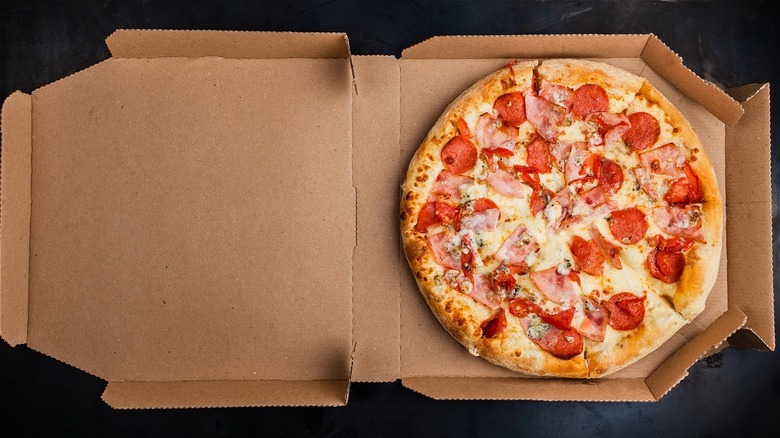Here's Why Pizza Boxes Are Still Getting Slammed
Who would have thought that pizza boxes would represent one of the major engineering challenges of the 20th century, a dilemma now stretching well into the 21st century? But, here we are. Sadly, as lamented recently in The Atlantic, the pizza box is not much improved from the first delivery boxes from the 1940s. Then, your pizza was delivered, or you picked it up from your neighborhood pizzeria, in a thin cardboard box. Not much different from the cake boxes still in use today, those first pizza boxes were hugely susceptible to weakening from the steam of a hot pizza and bending under its weight. And so, you were left to struggle against losing your fresh, hot pizza on the driveway — or worse, on the kitchen floor.
In the 1960s, recounts The Atlantic, the Domino's pizza chain commissioned a packaging company to manufacture pizza boxes out of much thicker corrugated cardboard — you know, like your Amazon delivery boxes — to better protect your pizza during pickup or delivery. Corrugated cardboard — two layers of cardboard, separated by an undulating layer of cardboard — also provides better insulation to keep your pizza hotter for longer. And, it allows some steam to escape, meaning your pizza is less soggy coming out of the box. But still, even a corrugated pizza box will degrade the quality of its contents, with trapped steam leaving it at least somewhat soggy, and as The Atlantic suggests, imparting "a rubbery grossness to the cheese."
Engineering issues confront pizza boxes
As of today, the only real innovation in pizza boxes has been the inclusion of the little plastic table inserted into the center of the pizza. Known as a "pizza saver," the little plastic piece keeps the steam-weakened top of the pizza box from sagging down into the pizza and snagging bits of cheese and toppings.
That's not to say there haven't been more ambitious attempts to improve the pizza box. One of the most notable came from Zume Inc., a food packaging company that took a run at this engineering challenge a few years ago. Zume's answer was the Pizza Pod, a round two-piece pizza container constructed of sugarcane fiber.
The Pizza Pod grew from Zume's initial pizza-centered business before the company moved into environmentally sustainable packaging. As explained by Machine Design, the innovative two-section round pizza box came with a lid tall and was rigid enough to stay off of the pizza. Other Pizza Pod innovations included bottom ridges, which added rigidity and also siphoned grease away from the pizza.
Zume holds nine patents with the Pizza Pod. Unfortunately, as Zume board chairman Alex Garden explains on LinkedIn, the "size and complexity of the Pod made it expensive and slow to make on existing packaging equipment" when it was developed in the mid-2010s.
The Pizza Pod does not appear today among products shown on the Zume website. So, for now anyway, pizza boxes remain a steamy, sticky problem in search of a solution.

